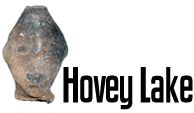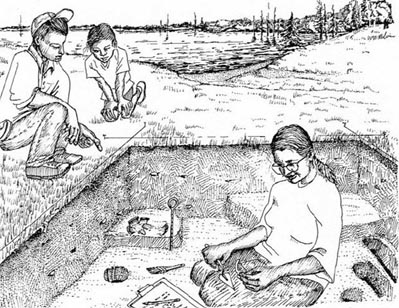 |
|
CURRENT
RESEARCH |
|
Learn
more about
Indiana Archaeology Month at Hovey Lake HERE! |
| Research
at the Hovey Lake site in 2003-2005 is supported by: a grant from
the Federal Highway Administration
(FHWA) under the Transportation Enhancement Program, Indiana
University, and private contributions. The Indiana
Department of Transportation (INDOT) administers the TE grant.
Also contributing to the research project are: Indiana
Geological Survey, Indiana
University - Bloomington Department of Anthropology, the Indiana
State Museum, University of Southern
Indiana, University of Evansville,
Indiana State University, and
community groups and volunteers. |
|
Last
Updated 9.6.2004
|
Abandonment

Sometime after A.D.1650, the Hovey Lake village was abandoned. Introduced European diseases may have weakened and decreased the population. Warfare is another possibility. We don’t yet know whether the villagers were concerned enough with defense to build a fortification wall around their village, but we do find evidence of intensive fires in some areas. During the late 1600s, warfare was widespread among native groups, and some native peoples in Indiana fled from the Iroquois.
By the late 1700s, the once flourishing village at the Hovey Lake site, as well as the neighboring Caborn-Welborn communities, were not recognized by the early European Americans who traveled through the region or the first Pioneers who settled in the Ohio Valley. Instead the newcomers met only hunting parties of tribes whose original homelands were to the east or north.
Did the village inhabitants
gradually drift away and resettle in distant areas as the population declined?
Or did the villagers quickly abandon their homes? These unanswered questions,
and others, require further research.

Testing at the Hovey
Lake site will continue on a small scale to allow preservation of the
majority of the site. Guided by research questions concerning the way
this community developed and declined over time, we hope to test and radiocarbon
date various parts of the village. Also, we will compare the Hovey Lake
data with other communities of the Caborn-Welborn culture. This will allow
us to have a better understanding of the daily life, social and political
organization of this Mississippian culture.


